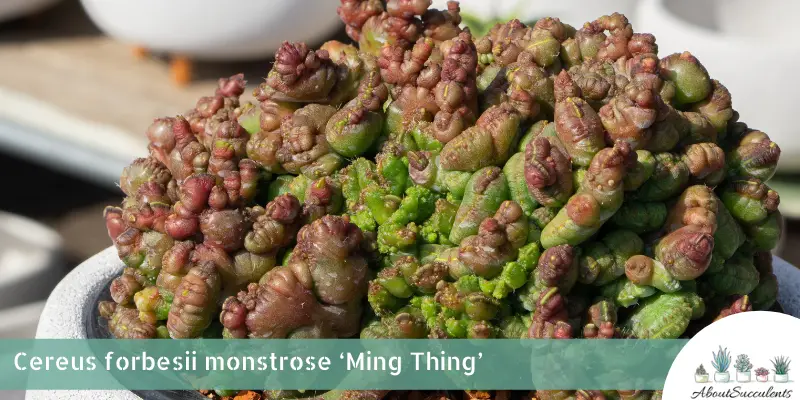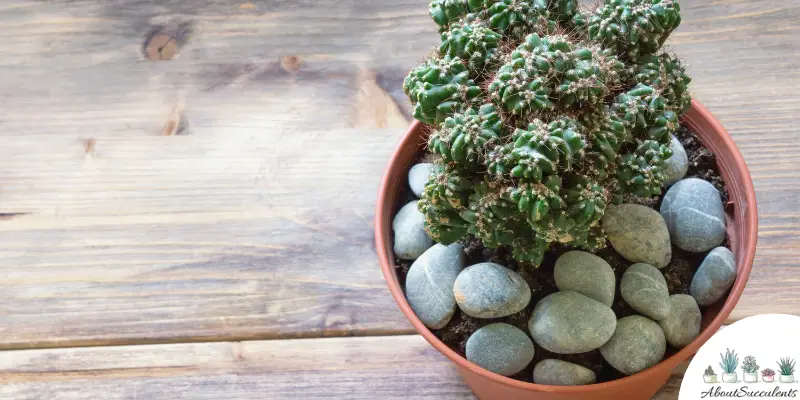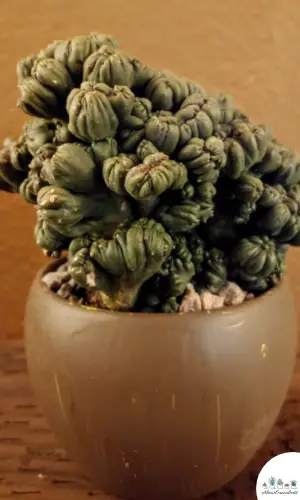
Cereus forbesii monstrose is also known as ‘Ming Thing’ and is a treelike cactus with blue-green columnar stems. The club-like stems have woolly brown areoles with short brown spines on top. Its unique appearance makes it a fascinating conversation piece in any garden.
Ming Thing thrives well in pots but it can also be grown in an outdoor rock garden. This eye-catching cactus forms clusters and grows up to 12-inches (30.5 cm) tall and 6-inches (15 cm) wide if planted in a pot. If planted outdoors, it grows up to 6 feet (2m).
When Cereus forbesii monstrose reaches maturity it produces large white and pale pink funnel-shaped flowers with hints of burgundy in early Spring. These lovely flowers bloom at night.
Cereus forbesii monstrose is native to Bolivia and Argentina. It is part of the Cereus genus from the Cactaceae family.
General Information
Also known as: Ming Thing
Plant Family: Cactaceae
Origin: Argentina and Bolivia
Height: 12-inches (30.5 cm)
Exposure: Partial to full sunlight but to help Ming Thing attain its maximum colors, full sunlight for up to 6 hours per day is recommended
Water Needs: Drought-tolerant; use the “Soak and Dry” watering method where you give the soil a thorough soaking only when it’s 100% dry.
Soil Type: Cactus or succulent soil mix combined with loam soil and gritty materials such as sand, perlite, gravel, and pumice
Soil pH: 6.0
How to Grow and Care for Cereus Forbesii Monstrose

Cereus forbesii monstrose is easy to grow and care for. Many succulent growers prefer to grow this plant in dish gardens because it makes a great conversation piece.
Ming Thing is not cold-hardy and cannot tolerate temperatures lower than -1.1°C (30°F).
Sunlight
Cereus forbesii monstrose grows happily when exposed to full sunlight for at least 6 hours every day. Place it near a sunny window if it’s potted indoors. If possible, take the pot outdoors during spring and summer where it can happily bask under the sun.
The potted cactus is vulnerable to etiolation, where the stems stretch out in search of a light source.
During winter, place the pot near a south-facing window. If your house is low in natural light it is best to get a grow light, so your Ming Thing will remain healthy and happy during the frosty season.
Watering

Use the “Soak and Dry” method to water your Cereus forbesii monstrose. Drench the soil with water and let it dry out completely before you water it again. This will ensure that the roots of your plant will not rot from standing in waterlogged soil.
To test the soil for dryness, insert a stick an inch deep. Pull out the stick and if its end is dry, prepare the water and give the soil a thorough soaking.
Ming Thing actively grows during Summer and Spring. Water your plant once every 7 to 10 days and only when the soil is dry.
During winter, when it enters its dormant phase, water your plant once a month and only when the soil is bone dry.
Pot and Soil
Use a terracotta or ceramic pot for your Cereus Forbesii Monstrose. This type of container is made with porous materials that allow proper soil aeration and moisture evaporation.
When it comes to pot size, get one that is 10% larger than the diameter of your plant. The roots of Ming Thing are not too long, so get a pot that is 4 to 7-inches (10.16 to 17.78 cm) deep to give ample space for root growth.
Ming Thing originates from arid lands, so it grows best in fast-draining soil. Use cactus or succulent soil mix combined with perlite, sand, or pumice.
Fertilize your cactus only when it is actively growing during Summer and Spring. Use a balanced, water-soluble, 10-10-10 fertilizer, and diluted to ¼ strength. Feed your plant 2 to three times during the growing season. Do not fertilize during winter.
How to Propagate Cereus Forbesii Monstrose
Ming Thing can be propagated from stem cuttings. The best time for propagation is during early spring to late summer.
Stem Cuttings
Step 1: Use a sterile sharp knife or pair of pruning shears to cut a stem from the mother plant.
Step 2: Leave the stem cutting in a warm and shaded area for 3 to 4 days or until the cut wound seals or calluses.
Step 3: Fill a terracotta pot with a drainage hole with cactus or succulent soil combined with perlite or pumice. Plant the calloused stem cutting (cut end first) into the soil. You can use wooden sticks to help the stem cutting stand upright.
Step 4: Place the pot in a partially shaded area. Mist the soil every day for two to three weeks or until new roots emerge. Use the ‘soak and dry’ watering method once the plant starts rooting.
Frequently Asked Questions
Is Cereus Forbesii Monstrose Toxic To Cats and Dogs?
Cereus forbesii monstrose is not included in the list of plants toxic to cats and dogs on the website of the American Society for the Prevention of Cruelty to Animals (ASPCA).
However, the spines on the stems of Ming Thing are sharp. It would be best to keep the plant away from pets and little children.
Why is my Cereus Forbesii Monstrose Dying?
When your Ming Thing looks unhealthy, you need to act quickly to reverse its condition. Your plant’s declining health may be due to the following reasons:
Overwatering
Cactus roots are prone to root rot, a disease caused by fungi that breed in waterlogged soil. When the stems of Ming Thing turn wrinkly and yellowish, it means that the roots are infected already.
You will need to re-pot your plant to save it from dying. Remove your cactus from the pot. Brush off all the soil from the roots. Use a sterile sharp knife or razor blade to cut all the black and mushy roots.
Air-dry the roots by laying your cactus on a mesh for two to three days. When the roots have dried completely, replant your cactus in a pot filled with fresh cactus potting mix. Wait three to four days before you water the soil.
If all the roots have been severely damaged, it is best to remove them. You can use the remaining healthy stems for propagation.
To prevent waterlogged soil, make sure to keep track of your watering schedule. Use only terracotta or ceramic pots with drainage holes filled with fast-draining soil.
Pest Infestation
Cereus forbesii monstrose is susceptible to mealybug infestation. When you see fuzzy white spots on the stems and soil, isolate your cactus immediately to protect other plants from getting infected.
If you have detected the presence of mealybugs early, you can remove them easily with a Q-tip dipped in 70% rubbing alcohol. Meticulously check every nook and cranny of your Ming Thing to be sure that you have removed all the bugs.
If the infestation has already progressed, you need to spray your plant and soil with 70% rubbing alcohol, diluted neem oil, or water with a few drops of dishwashing soap. Repeat the process until you remove all the bugs and eggs. The treatment can take three to four weeks.
During treatment, place the pot in a shaded area because alcohol and neem oil can cause sunburn. After treatment, remove your cactus from the pot. Disinfect the pot and discard the old soil. Fill the pot with fresh cactus mix and gritty materials. Plant your cactus and wait three to five days before you water the soil.
If your Monstrose cactus is planted outdoors, you could let loose ladybugs in your garden. These beetles can help you eliminate sap-sucking pests like aphids, mites, and mealybugs.
Yes, Cereus forbesii monstrose blooms large funnel-shaped white and pink flowers with hints of burgundy hues during Spring to early Summer.
Last Updated on June 9, 2022 by Sofia Lara